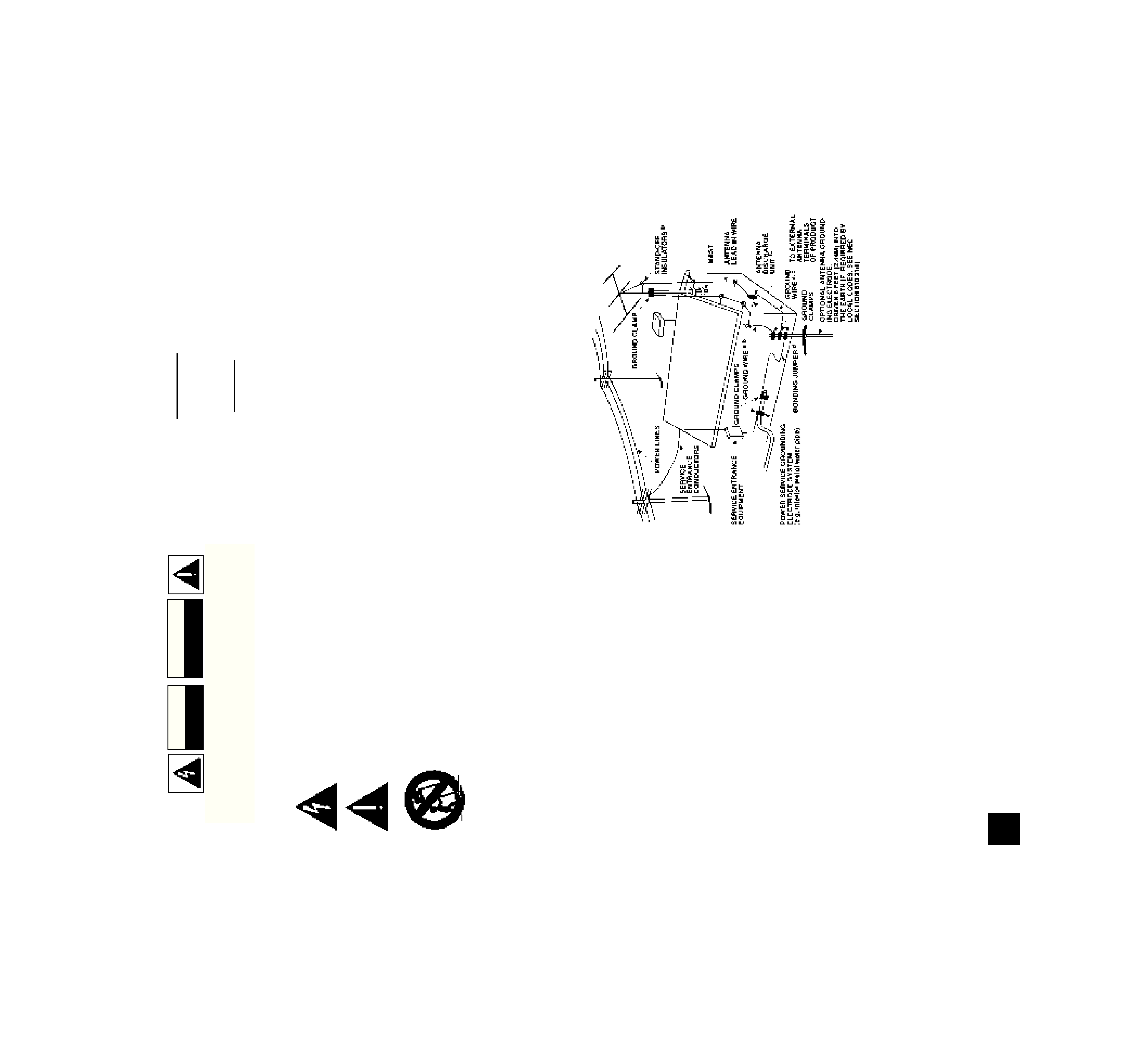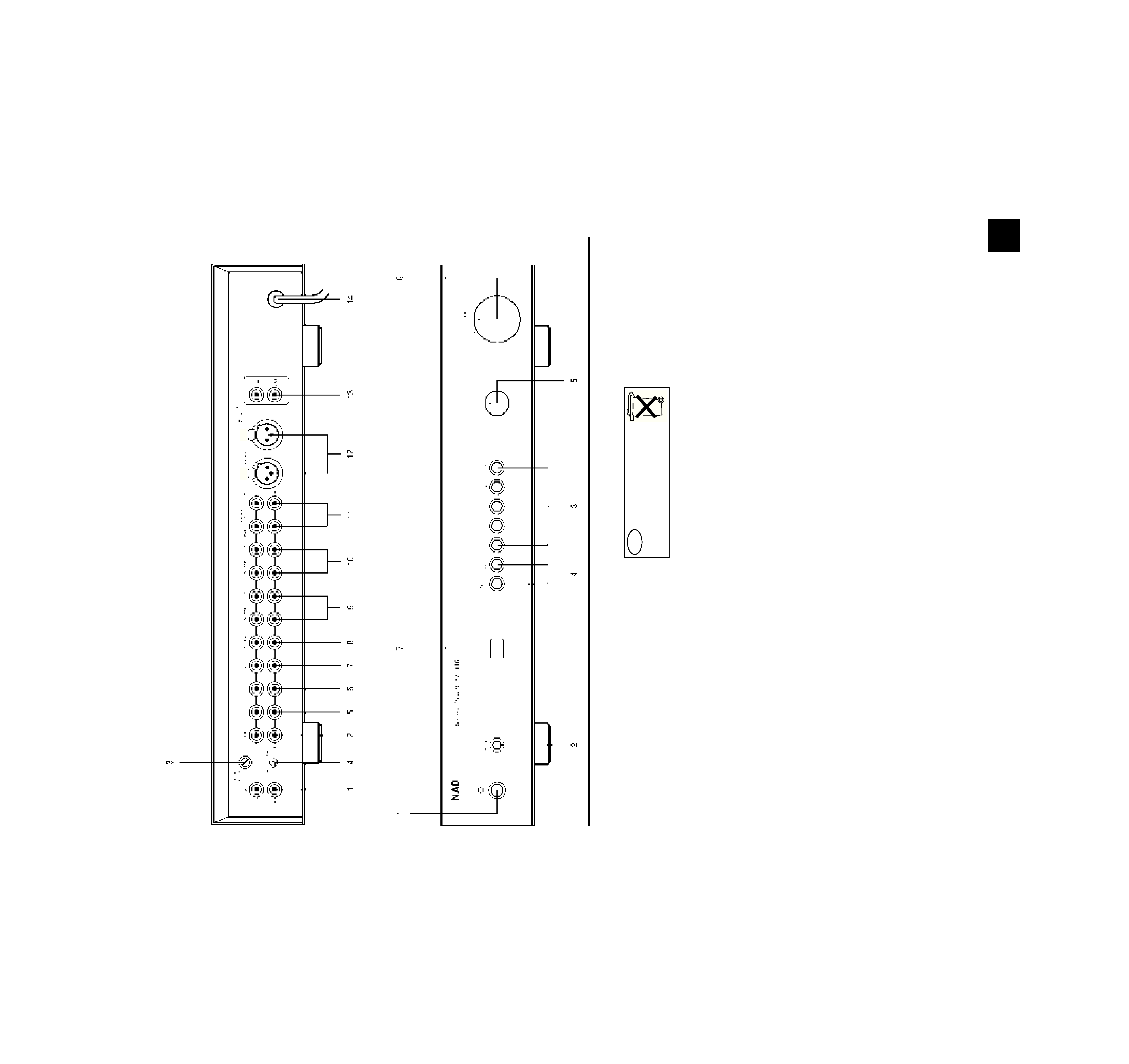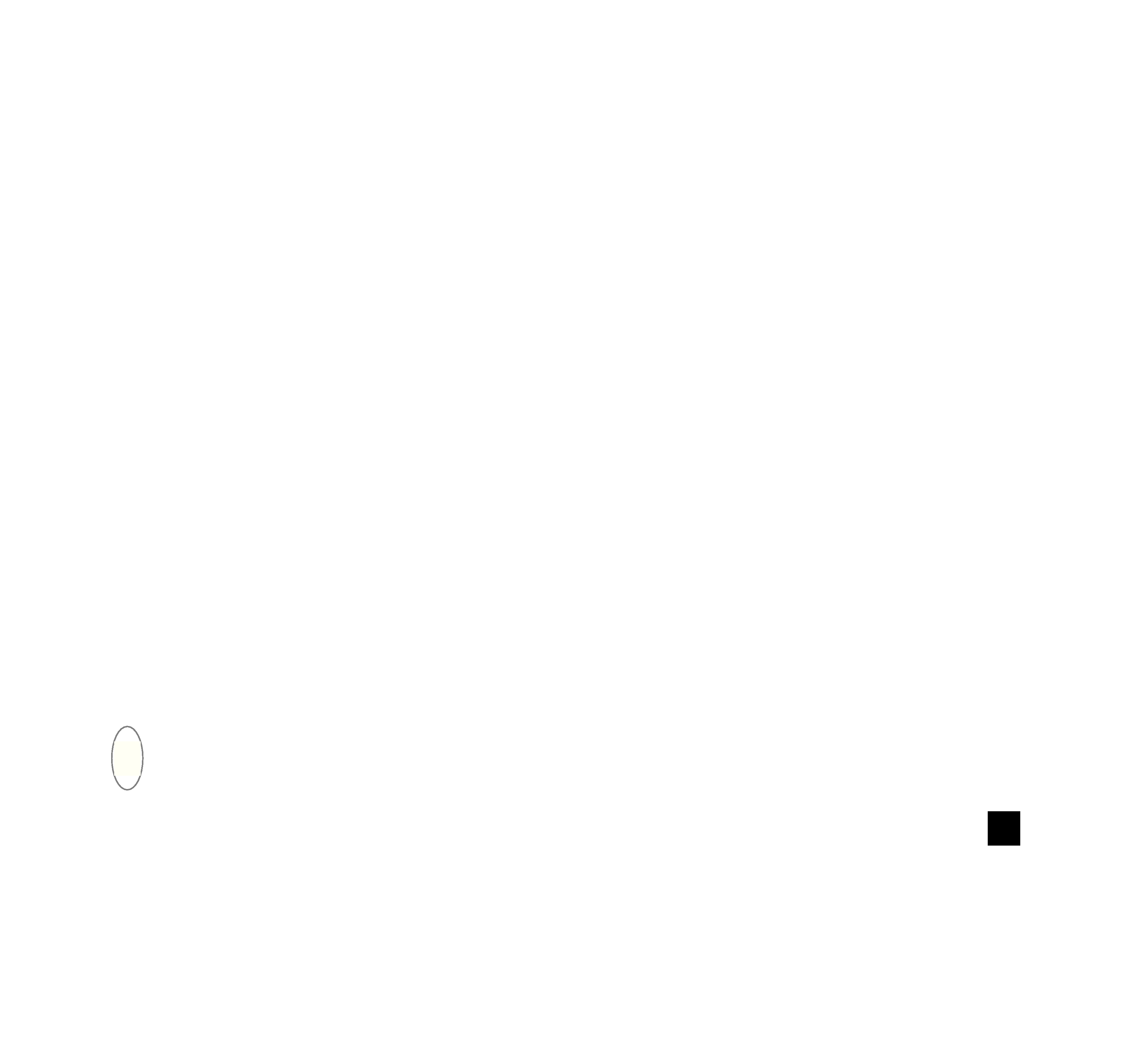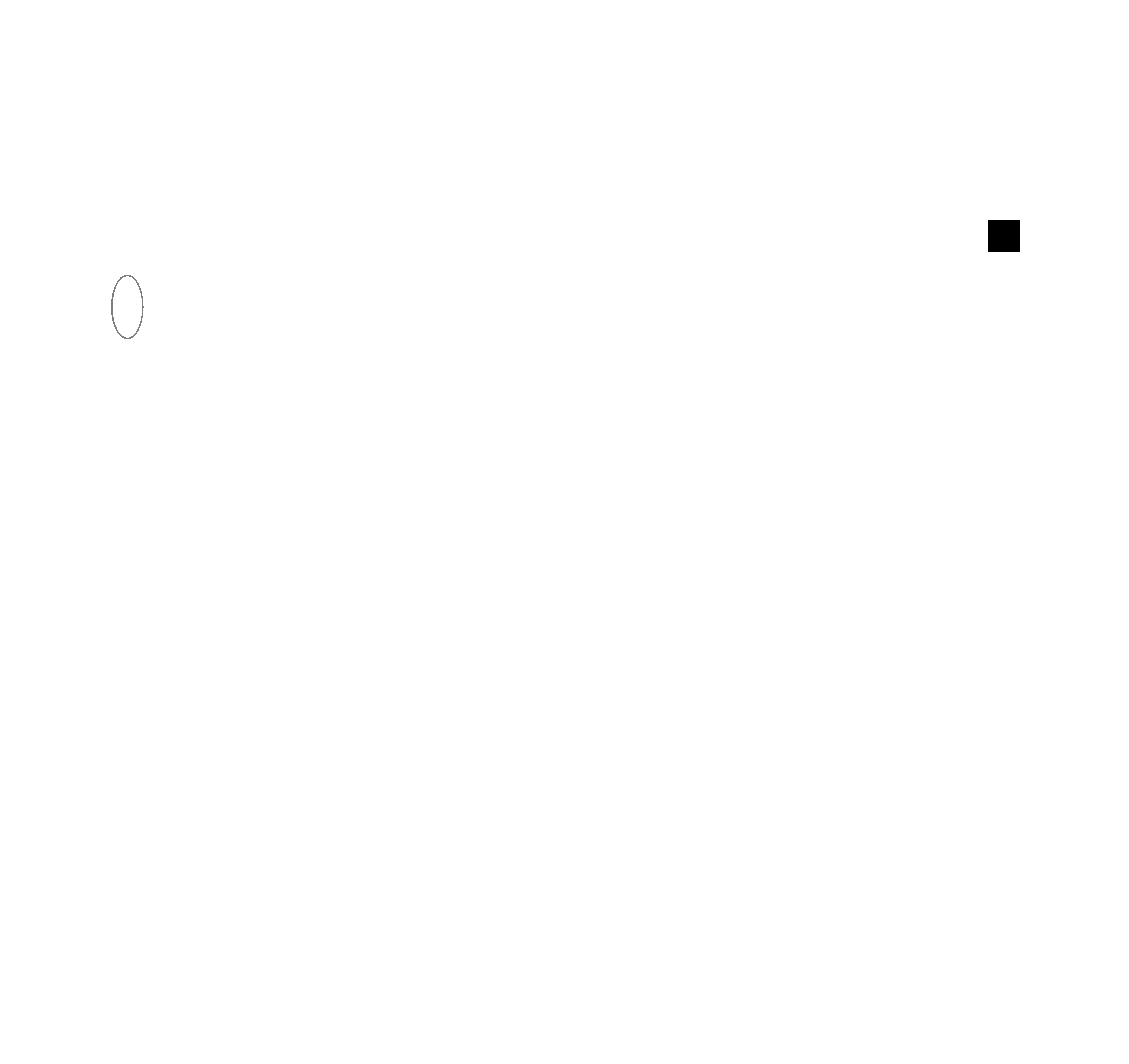
GB
F
D
E
I
P
S
NAD
116
· OWNER'S MANUAL
· MANUEL D'INSTALLATION
· BEDIENUNGSANLEITUNG
· MANUAL DEL USUARIO
· MANUALE DELLE ISTRUZIONI
· MANUAL DO PROPRIETÁRIO
· BRUKSANVISNING
©1996.
116.
NAD
ELECTRONICS
LTD.

Warning: To reduce the risk of fire or electric shock, do not expose this
unit to rain or moisture.
The lightning flash with an arrowhead symbol within an equilateral trian-
gle, is intended to alert the user to the presence of uninsulated "dan-
gerous voltage" within the product's enclosure that may be of suffi-
cient magnitude to constitute a risk of electric shock to persons.
The exclamation point within an equilateral triangle is intended to alert
the user to the presence of important operating and maintenance (ser-
vicing) instructions in the literature accompanying the product.
Do not place this unit on an unstable cart, stand or tripod,
bracket or table. The unit may fall, causing serious injury to a
child or adult and serious damage to the unit. Use only with a
cart, stand, tripod, bracket or table recommended by the man-
ufacturer or sold with the unit. Any mounting of the device on a
wall or ceiling should follow the maufacturer's instructions and
should use a mounting accessory recommended by the manu-
facturer.
An appliance and cart combination should be moved with care. Quick stops,
excessive force and uneven surfaces may cause the appliance and cart combi-
nation to overturn.
Read and follow all the safety and operating instructions before connecting or
using this unit. Retain this notice and the owner's manual for future reference.
All warnings on the unit and in it's operating instructions should be adhered to.
Do not use this unit near water; for example, near a bath tub, washbowl, kitchen
sink, laundry tub, in a wet basement or near a swimming pool.
The unit should be installed so that its location or position does not interfere with
its proper ventilation. For example, it should not be situated on a bed, sofa, rug
or similar surface that may block the ventilation openings; or placed in a built-in
installation, such as a bookcase or cabinet, that may impede the flow of air
through its ventilation openings.
The unit should be situated from heat sources such as radiators, heat registers,
stoves or other devices (including amplifiers) that produce heat.
The unit should be connected to a power supply outlet only of the voltage and
frequency marked on its rear panel.
The power supply cord should be routed so that it is not likely to be walked on or
pinched, especially near the plug, convenience receptacles, or where the cord
exits from the unit.
Unplug the unit from the wall outlet before cleaning. Never use benzine, thinner
or other solvents for cleaning. Use only a soft damp cloth.
The power supply cord of the unit should be unplugged from the wall outlet when
it is to be unused for a long period of time.
Care should be taken so that objects do not fall, and liquids are not spilled into
the enclosure through any openings.
This unit should be serviced by qualified service personnel when:
A. The power cord or the plug has been damaged; or
B. Objects have fallen, or liquid has been spilled into the unit; or
C. The unit has been exposed to rain or liquids of any kind; or
D. The unit does not appear to operate normally or exhibits a marked change in
performance; or
E. The device has been dropped or the enclosure damaged.
DO NOT ATTEMPT SERVICING OF THIS UNIT YOURSELF.
REFER SERVICING TO QUALIFIED SERVICE
PERSONNEL.
Upon completion of any servicing or repairs, request the service shop's assur-
ance that only Factory Authorized Replacement Parts with the same characteris-
tics as the original parts have been used, and that the routine safety checks
have been performed to guarantee that the equipment is in safe operating condi-
tion.
REPLACEMENT WITH UNAUTHORIZED PARTS MAY RESULT IN FIRE,
ELECTRIC SHOCK OR OTHER HAZARDS.
ATTENTION
POUR ÉVITER LES CHOC ELECTRIQUES, INTRODUIRE LA LAME
LA PLUS LARGE DE LA FICHE DANS LA BORNE CORRESPON-
DANTE DE LA PRISE ET POUSSER JUSQU'AU FOND.
CAUTION
TO PREVENT ELECTRIC SHOCK MATCH WIDE BLADE OF PLUG
TO WIDE SLOT FULLy INSERT.
If an indoor antenna is used (either built into the set or installed separately),
never allow any part of the antenna to touch the metal parts of other electrical
appliances such as a lamp, TV set etc.
CAUTION
POWER LINES
Any outdoor antenna must be located away from all power lines.
OUTDOOR ANTENNA GROUNDING
If an outside antenna is connected to your tuner or tuner-preamplifier, be sure
the antenna system is grounded so as to provide some protection against volt-
age surges and built-up static charges. Section 810 of the National Electrical
Code, ANSI/NFPA No. 70-1984, provides information with respect to proper
grounding of the mast and supporting structure, grounding of the lead-in wire to
an antenna discharge unit, size of grounding conductors, location of antenna dis-
charge unit, connection to grounding electrodes and requirements for the
grounding electrode.
a. Use No. 10 AWG (5.3mm2) copper, No. 8 AWG (8.4mm2) aluminium, No. 17
AWG (1.0mm2) copper-clad steel or bronze wire, or larger, as a ground wire.
b. Secure antenna lead-in and ground wires to house with stand-off insulators
spaced from 4-6 feet (1.22 - 1.83 m) apart.
c. Mount antenna discharge unit as close as possible to where lead-in enters
house.
d. Use jumper wire not smaller than No.6 AWG (13.3mm2) copper, or the equiva-
lent, when a separate antenna-grounding electrode is used. see NEC Section
810-21 (j).
EXAMPLE OF ANTENNA GROUNDING AS PER NATIONAL ELECTRICAL
CODE INSTRUCTIONS CONTAINED IN ARTICLE 810 - RADIO AND TELEVI-
SION EQUIPMENT.
NOTE TO CATV SYSTEM INSTALLER: This reminder is provided to
call the CATV system installer's attention to Article 820-22 of the
National Electrical Code that provides guidelines for proper grounding
and, in particular, specifies that the ground cable ground shall be con-
nected to the grounding system of the building, as close to the point of
cable entry as practical.
NAD
2
CAUTION
RISK OF ELECTRIC
SHOCK DO NOT OPEN
ATTENTION:
RISQUE DE CHOC ELECTRIQUE
NE PAS OUVRIR
CAUTION: TO REDUCE THE RISK OF ELECTRIC SHOCK,
DO NOT REMOVE COVER (OR BACK). NO USER
SERVICEABLE PARTS INSIDE. REFER SERVICING TO
QUALIFIED SERVICE PERSONNEL.
IMPORTANT SAFETY INSTRUCTIONS

NAD
3
REAR PANEL CONNECTIONS
FRONT PANEL CONTROLS
REMOTE CONTROL
©1996.
116.
NAD
ELECTRONICS
LTD.
Batterij niet
weggooien, maar
inleveren als KCA
NL
R
L

QUICK START.
1. Connect the RCA or XLR outputs to a power ampli-
fier.
2. Plug in the AC power cord.
3. Press the POWER button to turn the NAD 116 on.
4. Press the required input selector.
NOTES ON INSTALLATION.
Your NAD 116 should be placed on a firm, level
surface. Avoid placing the unit in direct sunlight or
near sources of heat and damp.
Allow adequate ventilation. Do not place the unit on
a soft surface like a carpet. Do not place it in an
enclosed position such as a bookcase or cabinet that
may impede the air-flow through the ventilation slots.
Switch the unit off before making any connections.
Some RCA connectors on your NAD 116 rear panel
are colour coded i.e. yellow for NAD-Link.
The NAD 116 comes with RCA leads for basic con-
nections. Where additional leads are required, use
high quality leads and connectors for optimum perfor-
mance and reliability. Ensure that leads and connec-
tors are not damaged in any way and all connectors
are firmly pushed home.
For best performance, connect your power amplifi-
er to the speakers with good quality speaker leads of
16 gauge thickness or more.
If the unit is not going to be used for some time,
disconnect the plug from the AC socket.
Should water get into your NAD 116, shut off the
power to the unit and remove the plug from the AC
socket. Have the unit inspected by a qualified service
technician before attempting to use it again.
Do not remove the cover, there are no user-ser-
viceable parts inside.
Use a dry soft cloth to clean the unit. If necessary,
lightly dampened the cloth with soapy water. Do not
use solutions containing benzol or other volatile
agents.
REAR PANEL CONNECTIONS.
1. MC INPUT
Input for a Moving Coil phono cartridge. Connect
the twin RCA lead from your turntable to this input if
you are using a Moving Coil cartridge.
2. MM INPUT
Input for a Moving Magnet phono cartridge.
Connect the twin RCA lead from your turntable to this
input if you are using a Moving Magnet cartridge.
3. PHONO (GROUND) CONNECTOR
The twin RCA lead from your turntable should also
include a single wire earth lead Connect this to the
NAD 116 phono (ground) connector.
4. MC-MM SWITCH
Use this switch to select the phono input you are
using.
5. CD INPUT
Input for a CD or other line-level signal source. Use
a twin RCA-to-RCA lead to connect the CD player left
and right `Audio Outputs' to this input. The NAD 116
only accepts analogue signals from your CD player.
6. VIDEO INPUT
Input for the audio signal from a stereo VCR (or
stereo TV/Satellite/Cable receiver) or other line-level
audio source. Using twin RCA-to-RCA leads, connect
to the left and right `Audio Out' of the unit to these
inputs. Note: These are audio inputs only.
7. AUX INPUT
Input for additional line level input signals such as
another CD player. Use a twin RCA-to-RCA lead to
connect the auxiliary unit's left and right `Audio
Outputs' to this input.
8. TUNER INPUT
Input for a Tuner or other line-level signal source.
Use a twin RCA-to-RCA lead to connect the Tuner
left and right `Audio Outputs' to this input.
9. TAPE 1 IN, OUT
Connections for analogue recording and playback
to an audio tape recorder of any type. Using twin
RCA-to-RCA leads, connect to the left and right
`Audio Output' of the tape machine to the TAPE 1 IN
connectors for playback and tape monitoring.
Connect the left and right `Audio Input' of the tape
machine to the TAPE 1 OUT connectors for record-
ing.
10. TAPE 2 IN, OUT
Connections for analogue recording and playback
to a secondary audio tape recorder of any type. Using
twin RCA-to-RCA leads, connect to the left and right
`Audio Output' of the tape machine to the TAPE 2 IN
connectors for playback. Connect the left and right
`Audio Input' of the tape machine to the TAPE 2 OUT
connectors for recording.
11. PRE 1, 2 OUT
Connections to an external power amplifier or
processor, such as a surround-sound decoder. Use a
twin RCA-to-RCA lead to connect to the left and right
`Audio Input' of the Power amp or processor to the
Pre Out connectors.
The Pre-Out output signal is controlled by the NAD
116's volume and balance control settings
These sockets provide connections to amplifiers
and processors requiring an unbalanced RCA con-
nections.
NAD
4
GB
NAD 116 STEREO PREAMPLIFIER

GB
12. BALANCED OUTPUTS
Connections to an external power amplifier or
processor that uses balanced XLR connectors.
These actively driven XLR outputs are suitable to
drive most balanced hi-fi and professional amplifiers.
The wiring standard used for these connectors is:
Pin 1 Chassis Earth (Ground)
Pin 2 Hot (Live )
Pin 3 Signal Ground (Return)
13. NAD-LINK IN, OUT
The NAD-Link connector is used to pass com-
mands from the remote control to and from other
units fitted with NAD-Link connectors. This allows
centralised control of a complete system or gives sys-
tem control from more than one room. To function
with other units, connect the NAD 116's NAD-Link
OUT to the NAD-Link IN on the other unit. NAD-Link
connectors can be daisy-chained, IN to OUT, so that
a whole system can be controlled from the remote
control facilities of one unit.
A single NAD-Link connection from a hi-fi system in
a second room will allow remote control of Multi
Room systems.
14. AC POWER CORD
After you complete all connections to the preampli-
fier, plug the AC line cord into a "live" AC socket.
FRONT PANEL CONTROLS.
POWER AND HEADPHONE FUNCTIONS.
1. POWER
Pressing the POWER switch turns the unit On and
after a few seconds the Power indicator LED will illu-
minate green. Pressing the POWER switch again will
turn the amplifier Off.
When the NAD 116 is switched On, pressing the
Standby button on the remote handset will put the
NAD 116 into Standby mode and the Power indicator
will turn amber. The amber Standby indicator shows
that power is being supplied to the NAD 116, but the
system is currently in the Standby Mode.
CAUTION: When in Standby, power is still supplied
to your NAD 116. You should switch it off using the
front panel Power switch when it is not being used for
long periods of time.
2. HEADPHONE SOCKET
A 1/4" stereo jack socket is supplied for headphone
listening and will work with conventional headphones
of any impedance. Inserting a headphone jack into
this socket automatically switches off the loudspeak-
ers. The volume and tone and balance controls are
operative for headphone listening. Use a suitable
adapter to connect headphones with other types of
connectors, such as 3.5mm stereo `personal stereo'
jack plugs.
WARNING: Make certain that the volume control is
turned to minimum (fully anti-clockwise) before con-
necting headphones.
Listening at high levels can damage your hearing.
INPUT SELECTORS.
3. INPUT SELECTORS
These buttons select the active input to the NAD
116 and the signal sent to the amplifier, the Tape out-
puts and the PRE OUT sockets.
LED's inside each button will indicate which input is
currently selected.
TUNER: Selects the tuner (or other line-level
source) connected to the Tuner sockets as the active
input.
AUX: Selects a line-level source connected to the
AUX sockets as the active input.
VIDEO:
Selects
the
VCR
(or
stereo
TV/Satellite/Cable receiver) connected to the VCR
sockets as the active input.
CD: Selects the CD (or other line-level source) con-
nected to the CD sockets,as the active input.
PHONO: Selects the turntable Phono cartridge
connected to either the MM or MC sockets as the
active input.
TAPE FUNCTIONS.
4. TAPE 1
Selects the output from a tape recorder when play-
ing back tapes or monitoring recordings being made
through the Tape 1 sockets. Press the Tape 1 button
once to select it and again to return to the normal
input selection.
Tape 1 is a tape Monitor function which does not
override the current input selection. For example, if
the CD is the active input when TAPE 1 is selected,
then the CD signal will continue to be selected and
sent to both the TAPE 1, and TAPE 2 OUTPUT sock-
ets, but it is the sound from recorder connected to
Tape 1 that will be heard on the loudspeakers.
To show which Input is active in when in Tape
Monitor mode, its indicator light will stay lit.
TAPE 2: Selects Tape 2 as the active input.
TO MAKE A RECORDING
When any source is selected, its signal is also fed
directly to any tape machine connected to the TAPE
1 or TAPE 2 OUTPUTS for recording.
TAPE TO TAPE COPYING
You can copy between two tape machines connect-
ed to your NAD 116. Put the source tape in the
recorder connected to Tape 2 and the blank tape into
the recorder connected to Tape 1. By selecting TAPE
2 Input you can now record from Tape 2 to Tape 1
and monitor the signal coming from the original tape.
Also you can use Tape 1 as the source and copy to
Tape 2 but Tape 1 monitor input has to be selected
for the duration of the recording.
CAUTION: WHEN TAPE 2 IS SELECTED, ONLY
ONE TAPE MACHINE SHOULD BE SET IN
NAD
5
